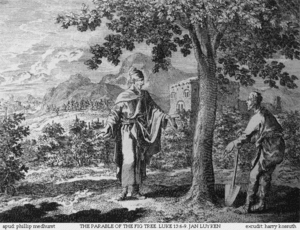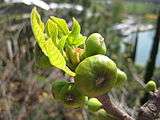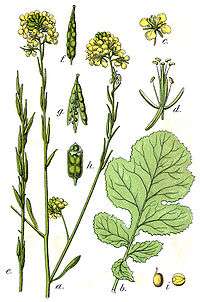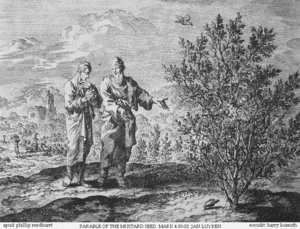Luke 13
Luke 13 is the thirteenth chapter of the Gospel of Luke in the New Testament of the Christian Bible. It records several parables and teachings told by Jesus Christ and his lamentation over the city of Jerusalem.[1] Jesus resumes his journey to Jerusalem which he has embarked upon in Luke 9:51. The book containing this chapter is anonymous, but early Christian tradition uniformly affirmed that Luke composed this Gospel as well as the Acts of the Apostles.[2]
| Luke 13 | |
|---|---|
 Luke 12:54-13:4 in Codex Alexandrinus, ca. AD 400-440. | |
| Book | Gospel of Luke |
| Category | Gospel |
| Christian Bible part | New Testament |
| Order in the Christian part | 3 |
Text
The original text was written in Koine Greek. This chapter is divided into 35 verses.
Textual witnesses
Some early manuscripts containing the text of this chapter are:
- Papyrus 75 (AD 175-225)
- Papyrus 45 (~250)
- Papyrus 138 (3rd century; extant verses 13–17, 25–30)[3]
- Codex Vaticanus (325-350)
- Codex Sinaiticus (330-360)
- Codex Bezae (~ 400)
- Codex Washingtonianus (~ 400)
- Codex Alexandrinus (400-440)
Sub-divisions
The New King James Version organises this chapter as follows (with cross references to other parts of the Bible):
- Luke 13:1-5 = Repent or Perish
- Luke 13:6-9 = The Parable of the Barren Fig Tree (Jeremiah 8:13)
- Luke 13:10-17 = A Spirit of Infirmity
- Luke 13:18-19 = The Parable of the Mustard Seed (Matthew 13:31-32; Mark 4:30-32)
- Luke 13:20-21 = The Parable of the Leaven (Matthew 13:33-35)
- Luke 13:22-33 = The Narrow Way
- Luke 13:34-35 = Jesus Laments over Jerusalem (Matthew 23:37-39; see also Luke 19:41)
Repent or Perish (verses 1–5)
Jesus received a report that the cruel ruler Pontius Pilate had killed some Galileans while they were worshiping God by offering sacrifices according to their Jewish religious law. Apparently those making the report were looking for Jesus to offer some explanation of why bad things happen to normal people—in this case even while they were worshiping.[4] It assumes that a victim must have done something terrible for God to allow something so tragic to happen to them.[5]
Jesus answered that the calamities suffered by the victims of the falling of the tower of Siloam were not related to their relative sinfulness and then diverted the focus onto the interrogators, wanting them to focus on their own souls.[5]
Do you think that these Galileans were worse sinners than all the other Galileans, because they suffered in this way? No, I tell you; but unless you repent, you will all likewise perish. Or those eighteen on whom the tower in Siloam fell and killed them: do you think that they were worse offenders than all the others who lived in Jerusalem? No, I tell you; but unless you repent, you will all likewise perish.” [Lk 13:2-5]
His mention of the fall of the Tower of Siloam added a nuance to his prior point: accidents happen. Therefore, even in the absence of persecution, death can come unexpectedly to anyone, irrespective of how righteous or how sinful they are. He may have been emphasizing that the time granted by God for repentance is limited.[4]
Parable of the barren fig tree (verses 6-9)


This parable of Jesus (not to be confused with the parable of the budding fig tree) appears only in the Gospel of Luke among the canonical gospels of the New Testament. In this parable, the owner is generally regarded as representing God, who had a fig tree ("tree of knowledge") planted in his vineyard ("the garden of Eden") and came seeking fruit ("righteous works", which in part is a mystery). The gardener (vinedresser) is God and the vine is Jesus ("tree of Life").[6] Fig trees were often planted in vineyards.[7] The fig tree was a common symbol for Israel, and may also have that meaning here,[6] or the tree in the parable may refer to the religious leadership.[7] In either case, the parable reflects Jesus offering his hearers one last chance for repentance.[7] "These three years" logically refers to the period of Jesus' ministry. The parable has been connected to the miracle of cursing the fig tree. Richard Whately commented that this parable "is one which our Lord may be said to have put before his hearers twice; once in words, once in action."[8]
Although the parable is found only in Luke's gospel, critics consider that there is no strong argument against its authenticity, for example a majority of the members of the Jesus Seminar voted it authentic.[7]
Jesus healing a crippled woman on the Sabbath (verses 10-17)
This healing miracle of Jesus appears only in the Gospel of Luke among the canonical gospels of the New Testament. According to Luke's account, Jesus was teaching in a synagogue on the Sabbath day, when he observed a woman who had been crippled "by a spirit" for eighteen years, and healed her with the words "You have been set free". This might therefore be classified as an exorcism. The gospel account relates the story as another example of Jesus clashing with religious authorities over how the Sabbath should be honoured: when the synagogue ruler tells the woman she should have come to be healed on a different day, Jesus denounces the synagogue leaders as hypocrites because they would release their animals to feed on the Sabbath, so why should this "daughter of Abraham" (verse 16) not be set free on the Sabbath from what is keeping her captive?
Verse 15 has the singular Greek: υποκριτα, hypokrita, in the Textus Receptus,[9] but the plural Greek: υποκριταi, hypokritai, in critical Greek texts such as the SBL Greek New Testament.[10] Hence the King James Version reads "Thou hypocrite",[11] addressing the synagogue leader only, whereas the New International Version reads "You hypocrites!".[12] Free church minister William Robertson Nicoll suggests that the comment was "directed against the class", i.e. the synagogue leaders collectively.[13]
Parable of the Mustard Seed (verses 18-19)


This parable is one of the shorter parables of Jesus. It appears in three of the canonical gospels of the New Testament. The differences between Gospels of Matthew (13:31–32), Mark (4:30–32), and Luke (13:18–19), are minor. In the Gospels of Matthew and Luke, it is immediately followed by the Parable of the Leaven, which shares this parable's theme of the Kingdom of Heaven growing from small beginnings.
A version of the parable also occurs in the non-canonical Gospel of Thomas 20.[14]
The plant referred to here is generally considered to be black mustard, a large annual plant up to 9 feet (2.7 m) tall,[15] but growing from a proverbially small seed:[15] this smallness is also used to refer to faith in Matthew 17:20 and Luke 17:6. According to rabbinical sources, Jews did not grow the plant in gardens,[15] and this is consistent with Matthew's description of it growing in a field. Luke tells the parable with the plant in a garden instead; this is presumably recasting the story for an audience outside Palestine.[15]
Parable of the Leaven (verses 20-21)

The Parable of the Leaven (also called the Parable of the yeast) is one of the shorter parables of Jesus. It appears in two of the canonical gospels of the New Testament. The differences between Gospels of Matthew (Matthew 13:33) and Luke (Luke 13:20–21) are minor. In both places it immediately follows the Parable of the Mustard Seed, which shares this parable's theme of the Kingdom of Heaven growing from small beginnings.
A version of the parable also occurs in the non-canonical Gospel of Thomas (96[14]).
The narrow door (verses 22-30)
In this pericope Jesus teaches that few will be saved, because the door to salvation is narrow. Matthew 7:13 is another version of this.
Jesus laments over Jerusalem (verses 31-35)
Jesus confirms that he must continue to Jerusalem. Both here, on the journey, and at Luke 19:41 when the city is in sight, Jesus contemplates the significance and fate of Jerusalem, the holy city.
Old Testament references
See also
- Sermon on the Mount
- Sermon on the Plain
- Ministry of Jesus
- Parables of Jesus
- Other related Bible parts: Psalm 6, Matthew 13, 23; Mark 4; Luke 19
References
- Halley, Henry H. Halley's Bible Handbook: an Abbreviated Bible Commentary. 23rd edition. Zondervan Publishing House. 1962.
- Holman Illustrated Bible Handbook. Holman Bible Publishers, Nashville, Tennessee. 2012.
- "1. Theological Texts: 5346 Luke XIII 13–17, 25–30 (pp. 7ff)". Egypt Exploration Society. Retrieved 2018-05-25.
- "» A magnifying glass on the Galileans, the Blood, the Tower of Siloam, and the Vineyard of Luke 13:1-9: One Faith, One Church". Onefaithonechurch.com. Retrieved 2014-02-19.
- Piper, John (1988-06-05). "Unless You Repent You Will All Likewise Perish". Desiring God. Retrieved 2014-02-19.
- Timothy Maurice Pianzin, Parables of Jesus: In the Light of Its Historical, Geographical & Socio-Cultural Setting, Tate Publishing, 2008, ISBN 1-60247-923-2, pp. 235-237.
- Peter Rhea Jones, Studying the Parables of Jesus, Smyth & Helwys, 1999, ISBN 1-57312-167-3, pp. 123-133.
- Richard Whately, Lectures on Some of the Scripture Parables, John W. Parker and Son, 1859, p. 153.
- Luke 13:15: 1550 Stephanus New Testament
- Luke 13:15: SBL Greek New Testament
- Luke 13:15: KJV
- Luke 13:15 NIV
- Nicoll, W. R. (1897 ff), Expositor's Greek Testament on Luke 13, accessed 23 August 2019
- Gospel of Thomas: Lamb translation and Patterson/Meyer translation.
- I. Howard Marshall, The Gospel of Luke: A commentary on the Greek text, Eerdmans, 1978, ISBN 0-8028-3512-0, pp. 561.
- Kirkpatrick, A. F. (1901). The Book of Psalms: with Introduction and Notes. The Cambridge Bible for Schools and Colleges. Book IV and V: Psalms XC-CL. Cambridge: At the University Press. p. 838. Retrieved February 28, 2019.
External links
- Luke 13 King James Bible - Wikisource
- English Translation with Parallel Latin Vulgate
- Online Bible at GospelHall.org (ESV, KJV, Darby, American Standard Version, Bible in Basic English)
- Multiple bible versions at Bible Gateway (NKJV, NIV, NRSV etc.)
| Preceded by Luke 12 |
Chapters of the Bible Gospel of Luke |
Succeeded by Luke 14 |